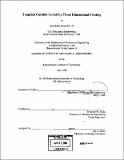| dc.contributor.advisor | Emanuel M. Sachs. | en_US |
| dc.contributor.author | Kelley, Andrew, III | en_US |
| dc.contributor.other | Massachusetts Institute of Technology. Dept. of Mechanical Engineering. | en_US |
| dc.date.accessioned | 2006-03-29T18:33:37Z | |
| dc.date.available | 2006-03-29T18:33:37Z | |
| dc.date.copyright | 1998 | en_US |
| dc.date.issued | 1998 | en_US |
| dc.identifier.uri | http://hdl.handle.net/1721.1/32316 | |
| dc.description | Thesis (S.M.)--Massachusetts Institute of Technology, Dept. of Mechanical Engineering, 1998. | en_US |
| dc.description | Includes bibliographical references (p. 69-70). | en_US |
| dc.description.abstract | Three Dimensional Printing is an additive manufacturing process for rapid prototyping ceramic and metallic parts [Sachs, et al, 1990]. Green (not sintered) tungsten carbide-cobalt parts must have a density greater than 50% of the theoretical density, 14.9 g/cc, for proper sintering and post-processing. Two approaches were assessed for feasibility and robustness: printing slurry into tungsten carbide-cobalt spray dried powder and printing a solvent in spray dried tungsten carbide powder that readily dissolves. For slurry administered to a powder bed of solid, spherical particles, it has been found that the resulting packing primitive packing fraction increases almost linearly with the volume loading of the slurry over a range of powder size. The increase in density is approximately half what would be calculated by assuming that the slurry fills all the porosity in the powder bed. The maximum green density achieved by printing slurry into a spray dried tungsten carbide-cobalt bed was 41%, midway between the lower bound calculated by assuming the vehicle in the slurry infiltrates only the large pores between the spray dried power and the upper bound calculated by assuming that the vehicle of the slurry also infiltrates the find pores within a spray dried granule. A re-dispersible spray dried powder (38-53 micron size range) was fabricated using only the Duramax 3007 dispersant as the binder. This powder redisperses in water. Administering a drop of water to this powder resulted in primitives with 47% packing density, but which had significant quantities of 80 micron voids. | en_US |
| dc.description.abstract | (cont.) Several lines of evidence pointed to the hypothesis that the voids were the result of trapped air. Two methods were successfully employed to nearly eliminate such voids. In one approach, the droplet of water wvas administered to the powder bed under a vacuum of between 25 and 40 torr and air was admitted to the chamber to 1 atmosphere after different intervals of time ranging from 30 seconds to 10 minutes. In another approach, the ability of water to absorb CO₂ was used to "getter" any trapped gas into the liquid. Water was administered to a powder bed under a CO₂ environment at room temperature. After a 2 minute period, intended to allow the spray dried powder to substantially re-disperse, the temperture of the powder bed was lowered to 0-5 degrees Centigrade in order to increase the amount of CO₂ which could be absorbed in the water and "switch on" the gettering of the trapped gas.Controls were run with the same procedure in air. The primitives made under CO₂ were nearly void free and had densities as high as 52%, while the controls were not significantly different than primitives made at room temperature in air. | en_US |
| dc.description.statementofresponsibility | by Andrew Kelley, III. | en_US |
| dc.format.extent | 93 p. | en_US |
| dc.format.extent | 5549025 bytes | |
| dc.format.extent | 5553728 bytes | |
| dc.format.mimetype | application/pdf | |
| dc.format.mimetype | application/pdf | |
| dc.language.iso | eng | en_US |
| dc.publisher | Massachusetts Institute of Technology | en_US |
| dc.rights | M.I.T. theses are protected by copyright. They may be viewed from this source for any purpose, but reproduction or distribution in any format is prohibited without written permission. See provided URL for inquiries about permission. | en_US |
| dc.rights.uri | http://dspace.mit.edu/handle/1721.1/7582 | |
| dc.subject | Mechanical Engineering. | en_US |
| dc.title | Tungsten carbide-cobalt by Three Dimensional Printing | en_US |
| dc.type | Thesis | en_US |
| dc.description.degree | S.M. | en_US |
| dc.contributor.department | Massachusetts Institute of Technology. Department of Mechanical Engineering | |
| dc.identifier.oclc | 61367225 | en_US |
